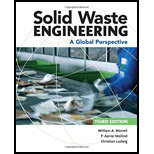
Concept explainers
The difference between pyrolysis and gasification.
Explanation of Solution
Pyrolysis is the process in which combustion takes place in the absence of oxygen. It is the thermal method of decomposition at high temperature in a nonreactive environment. This method is mainly used for decomposition of organic waste. Generally, the organic substance is volatile in nature so, during pyrolysis, they leave the solid material and gets evaporated at an elevated temperature which is enriching in carbon and charcoal.
Gasification is the process in which the organic matter is decomposed in the presence of oxygen at elevated temperature. In this process, organic matter is disintegrated into hydrogen, carbon monoxide, and carbon dioxide. The product of this process is used as a renewable source of energy.
Want to see more full solutions like this?
Chapter 7 Solutions
Solid Waste Engineering
- Deformation of a retaining wall is assumed to be as presented in the figure below. Determine:a) variation of the active and passive pressures on the wall for the presented deformation b) magnitude of the total horizontal force on the right side of the wall.arrow_forward2. a) Consider a cable used for aerial tramway (see figure a). The span is 400 m. The unstretched length of the cable is 402 m. Its mass per unit length is 10kg. The elasticity EA = 10 N. Find the horizontal load on the two ends and the sag d. Determine if the small sag condition is satisfied. b) When a cable car whose mass is 500kg is hung below the cable at a horizontal distance of 100 m from the left end, find the horizontal load on the ends. C) As the car goes along the cable, at which position you will see maximum horizontal load on the two ends?arrow_forwardTwo square surface footings are placed 20 feet apart. Calculate ultimate settlements beneath footing I and at the centerline of the two footings.arrow_forward
- Find the bending moment diagram for. structure drawn below using castigliani's Second theorems. 10kN/m A B 5m 10marrow_forwardDesign the foundation in Problem 3 (find the radius), for the assumptions that the failure isgeneral, sand is dry, loading Q=6000 kN, and the factory of safety is 2.4.arrow_forwardAssume that the moist unit weight of sand in Problem 1 to be 122 lb/ft3, the saturated unit weight of sand 130 and clay 120 lb/ft 3. What should be the thickness of a soil layer of a unit weight of 120 lb/ft 3 that would cause consolidation settlement of 0.1 ft in 100 days?arrow_forward
- Define the allowable bearing capacity of a circular foundation of a radius 2R=10 ft using theTerzaghi's bearing capacity equation for a local failure. In your calculations assume two scenarios:a) that the ground water table matches the bottom of the foundation, and b) that the ground watertable is 6 ft below the bottom of the foundation. Use a factor of safety of 2.8, and the dry unit weightabove the ground water table.arrow_forwardFor the square foundation below determine: a) ultimate settlement and b) settlement after 140days due to consolidation of the clay layer. Base your calculations on the values at the midpoint ofthe layer.arrow_forwardEvaluate all reactions & internalforces using Moment DistributionE=29000ksi I=400in^(4) for all members.arrow_forward
- A silty sand sample failed during a consolidated-undrained triaxial test at F1=280 kPa andF3=170 kPa. With the assumption that c=0 and A=0.65, determine the consolidated-undrainedfriction angle Ncu and a drained friction angle N. If a consolidated-undrained test on such a soil isconducted at a confining pressure F3 =340 kPa, what will be major total and effective stresses andthe pore water pressure at failure? What will be the maximum shear stress J during a "slow" directshear test, if the vertical stress Fv=160 kPa?arrow_forwardCheck the adequacy of a 15ft long A992 W12x65 beam-column shown in figure (1). The axial loads and end moments have been obtained from 2nd order analysis of the gravity loads. The frame and loading are symmetric. Assume that (Cb) is 1.06. PD-85k, PL-220k MD-15k-ft, ML-45k-ft Le-8.6ft MD-18k-ft, ML-52kfarrow_forwardecos y dyarrow_forward
 Solid Waste EngineeringCivil EngineeringISBN:9781305635203Author:Worrell, William A.Publisher:Cengage Learning,
Solid Waste EngineeringCivil EngineeringISBN:9781305635203Author:Worrell, William A.Publisher:Cengage Learning,
 Materials Science And Engineering PropertiesCivil EngineeringISBN:9781111988609Author:Charles GilmorePublisher:Cengage Learning
Materials Science And Engineering PropertiesCivil EngineeringISBN:9781111988609Author:Charles GilmorePublisher:Cengage Learning Engineering Fundamentals: An Introduction to Engi...Civil EngineeringISBN:9781305084766Author:Saeed MoaveniPublisher:Cengage Learning
Engineering Fundamentals: An Introduction to Engi...Civil EngineeringISBN:9781305084766Author:Saeed MoaveniPublisher:Cengage Learning Construction Materials, Methods and Techniques (M...Civil EngineeringISBN:9781305086272Author:William P. Spence, Eva KultermannPublisher:Cengage Learning
Construction Materials, Methods and Techniques (M...Civil EngineeringISBN:9781305086272Author:William P. Spence, Eva KultermannPublisher:Cengage Learning




